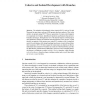Free Online Productivity Tools
i2Speak
i2Symbol
i2OCR
iTex2Img
iWeb2Print
iWeb2Shot
i2Type
iPdf2Split
iPdf2Merge
i2Bopomofo
i2Arabic
i2Style
i2Image
i2PDF
iLatex2Rtf
Sci2ools
FASE
2012
Springer
2012
Springer
Cohesive and Isolated Development with Branches
The adoption of distributed version control (DVC), such as Git and Mercurial, in open-source software (OSS) projects has been explosive. Why is this and how are projects using DVC? This new generation of version control supports two important new features: distributed repositories and histories that preserve branches and merges. Through interviews with lead developers in OSS projects and a quantitative analysis of mined data from the histories of sixty project, we find that the vast majority of the projects now using DVC continue to use a centralized model of code sharing, while using branching much more extensively than before their transition to DVC. We then examine the Linux history in depth in an effort to understand and evaluate how branches are used and what benefits they provide. We find that they enable natural collaborative processes: DVC branching allows developers to collaborate on tasks in highly cohesive branches, while enjoying reduced interference from developers work...
| Added | 21 Apr 2012 |
| Updated | 21 Apr 2012 |
| Type | Journal |
| Year | 2012 |
| Where | FASE |
| Authors | Earl T. Barr, Christian Bird, Peter C. Rigby, Abram Hindle, Daniel M. Germán, Premkumar T. Devanbu |
Comments (0)

